一种对糜子黑穗病有生物防治作用的植物促生菌——毒霉链霉菌
IF 3.4
2区 农林科学
Q2 BIOTECHNOLOGY & APPLIED MICROBIOLOGY
引用次数: 0
摘要
黑穗病是对糜子的重大威胁之一。为了农业的可持续发展,寻找一种安全的防治方法至关重要。为了解决这一问题,我们从糜子根际土壤中分离出不同的菌株。其中,18株菌株对黑穗病有抑制作用,其中v-3菌株的抑制效果最好。v-3菌株的形态特征表明,菌落呈肉桂粉色,表面粗糙不透明。孢子呈浅粉红色,气生菌丝发育良好。这种菌株被发现能产生蛋白酶、硫化氢和黑色素。最后通过16S rDNA测序证实该菌株与毒菌链霉菌亲缘关系密切。2021 ~ 2022年,将v-3菌株制备为孢子悬浮液(SS)和无菌发酵液(SF)进行田间实验。结果表明,施用SS和SF后,高粱黑穗病的病株率分别降低39.55% ~ 55.29%和50.91% ~ 63.14%。控制率也分别增加了39.46% ~ 59.05%和50.96% ~ 62.99%。此外,v-3菌株显著促进了糜子地上性状(株高、茎粗)和地下性状(根鲜重、根长、根表面积)的生长。提高了叶片中抗氧化酶(超氧化物歧化酶、过氧化物酶和过氧化氢酶)的活性,降低了丙二醛含量。上述结果初步表明,v-3菌株对糜子黑穗病具有生物防治潜力,能促进糜子的生长。本文章由计算机程序翻译,如有差异,请以英文原文为准。
Streptomyces toxytricini, a biocontrol plant growth-promoting bacterium against smut of broomcorn millet (Panicum miliaceum L.)
Smut disease is one of the significant threats to broomcorn millet. It is essential to find a safe method to control this disease for sustainable agricultural development. To address this issue, we isolated various strains from the rhizosphere soil of broomcorn millet. Among these, 18 strains exhibited inhibitory effects on smut, with the v-3 strain demonstrating the best control effect. The morphological characteristics of the v-3 strain showed that the colony was cinnamon pink, and the surface was rough and opaque. The spores were light pink, and the aerial hyphae were well-developed. This strain was found to produce protease, hydrogen sulfide, and melanin. Finally, 16S rDNA sequencing confirmed that the strain is closely related to Streptomyces toxytricini. From 2021 to 2022, the v-3 strain was prepared as spore suspension (SS) and sterile fermentation broth (SF) for field experiments. The results showed that the disease plant rate of broomcorn millet smut was reduced by 39.55%∼55.29% and 50.91%∼63.14% after using SS and SF, respectively. Similary, the control rate increased 39.46%∼59.05% and 50.96%∼62.99%, respectively. Furthermore, the v-3 strain significantly promoted the growth of aboveground traits (plant height and stem diameter) and underground traits (root fresh weight, root length, and root surface area) of broomcorn millet. It also improved the activity of antioxidant enzymes (superoxide dismutase, peroxidase, and catalase) in the leaves, and reduced the malondialdehyde content. These findings preliminarily indicate that the v-3 strain has biocontrol potential against broomcorn millet smut and could promote the growth of broomcorn millet.
求助全文
通过发布文献求助,成功后即可免费获取论文全文。
去求助
来源期刊

Biological Control
生物-昆虫学
CiteScore
7.40
自引率
7.10%
发文量
220
审稿时长
63 days
期刊介绍:
Biological control is an environmentally sound and effective means of reducing or mitigating pests and pest effects through the use of natural enemies. The aim of Biological Control is to promote this science and technology through publication of original research articles and reviews of research and theory. The journal devotes a section to reports on biotechnologies dealing with the elucidation and use of genes or gene products for the enhancement of biological control agents.
The journal encompasses biological control of viral, microbial, nematode, insect, mite, weed, and vertebrate pests in agriculture, aquatic, forest, natural resource, stored product, and urban environments. Biological control of arthropod pests of human and domestic animals is also included. Ecological, molecular, and biotechnological approaches to the understanding of biological control are welcome.
 求助内容:
求助内容: 应助结果提醒方式:
应助结果提醒方式:


